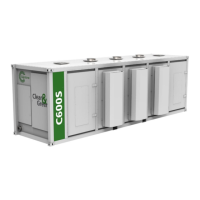Capstone Turbine Corporation • 16640 Stagg Street • Van Nuys • CA 91406 • USA
Installation Guide: Capstone C1000S/C800S/C600S with C1000 Series Controller
480064 Rev C (December 2018) Page 61 of 122
Capstone reserves the right to change or modify, without notice, the design, specifications, and/or contents of this document without
incurring any obligation either with respect to equipment previously sold or in the process of construction.
6.5.1.1. Regulators
Capstone recommends that a fuel pressure regulator be installed at each microturbine. This is
especially important in large installations, where fuel pipe volume after a single, large regulator
can lead to significant pressure variation between units. Install the fuel pressure regulator as close
to the microturbine inlet as practical. A regulator installed too far away from the microturbine will
not adequately control the fuel pressure. The pressure regulator should have sufficient pressure
drop and size to compensate for variations at the regulator inlet.
6.5.1.2. Pressure Drop
When designing a fuel delivery system or sizing a compressor, the pressure drop across the
system must be considered. Pressure drop is the amount of pressure lost between the high
pressure source and the microturbine inlet. Pressure drop is a function of the length and diameter
of the pipe, number of bends in the pipe, and each individual component installed in the piping.
For example, if the minimum allowable pressure to the microturbine is 75 psig and the fuel system
has a pressure drop of 20 psi between the compressor outlet and the microturbine inlet, then the
compressor outlet must be at least 20 psi above the minimum allowable pressure — at least 95
psig for this example. Adding a pressure gauge at the microturbine inlet can assist in establishing
the correct settings.
6.5.2. Dew Point Suppression
Capstone microturbines require strict dew point suppression, which is the amount of moisture
removal needed to protect the microturbine from internal condensation. Cooling of the gas in
process piping — usually due to ambient temperatures that are lower than the fuel temperature
— and gas compression can cause condensation. The fuel temperature at the microturbine inlet
must be a minimum 10 °C (18 °F) above its dew point temperature or 0 °C (32 °F), whichever is
higher. Failure to prevent condensation inside the microturbine negatively impacts the life of the
unit.
6.5.3. Condensate Removal
Condensate consists of water and other contaminants and must be disposed of accordingly.
Manual or automatic condensate removal techniques can be applied depending on the
application. Manual ball valves piped to a condensate drain and collector are low cost, but will
require an experienced site operator to be properly utilized. Automatic valves can be actuated
based on vessel level switch or timer-based inputs. Items to consider are as follows:
Water will freeze in condensate drain lines, so heat tracing may be required to prevent
clogging of condensate systems in cold environments.
Drain lines from all condensate producing devices should be directed toward appropriate
drainage disposal facilities or equipment.
All piping must have provision for gravity drainage. If the pipe goes underground or has
a low point, the condensate will collect there and must be drained. Each pipe must either
slope toward a vessel with a drain or take appropriate measures for condensate
drainage.
Avoid over-pressurizing drainage lines. Condensate drain lines from high-pressure
sources should not be tied together with drain lines from low-pressure sources. Ideally,
all drain lines should be kept separate.

